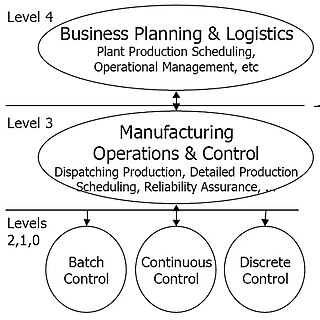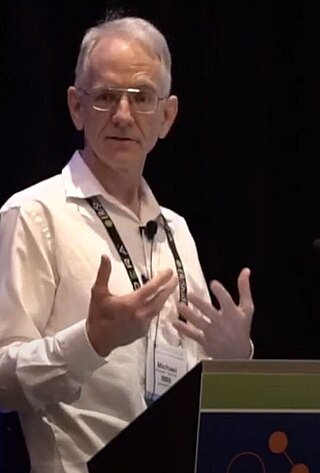In information science, an ontology encompasses a representation, formal naming, and definitions of the categories, properties, and relations between the concepts, data, or entities that pertain to one, many, or all domains of discourse. More simply, an ontology is a way of showing the properties of a subject area and how they are related, by defining a set of terms and relational expressions that represent the entities in that subject area. The field which studies ontologies so conceived is sometimes referred to as applied ontology.

IDEF, initially an abbreviation of ICAM Definition and renamed in 1999 as Integration Definition, is a family of modeling languages in the field of systems and software engineering. They cover a wide range of uses from functional modeling to data, simulation, object-oriented analysis and design, and knowledge acquisition. These definition languages were developed under funding from U.S. Air Force and, although still most commonly used by them and other military and United States Department of Defense (DoD) agencies, are in the public domain.

Scott Elliott Fahlman is an American computer scientist and Professor Emeritus at Carnegie Mellon University's Language Technologies Institute and Computer Science Department. He is notable for early work on automated planning and scheduling in a blocks world, on semantic networks, on neural networks, on the programming languages Dylan, and Common Lisp, and he was one of the founders of Lucid Inc. During the period when it was standardized, he was recognized as "the leader of Common Lisp." From 2006 to 2015, Fahlman was engaged in developing a knowledge base named Scone, based in part on his thesis work on the NETL Semantic Network. He also is credited with coining the use of the emoticon.

CIMOSA, standing for "Computer Integrated Manufacturing Open System Architecture", is an enterprise modeling framework, which aims to support the enterprise integration of machines, computers and people. The framework is based on the system life cycle concept, and offers a modelling language, methodology and supporting technology to support these goals.
The Personal Software Process (PSP) is a structured software development process that is designed to help software engineers better understand and improve their performance by bringing discipline to the way they develop software and tracking their predicted and actual development of the code. It clearly shows developers how to manage the quality of their products, how to make a sound plan, and how to make commitments. It also offers them the data to justify their plans. They can evaluate their work and suggest improvement direction by analyzing and reviewing development time, defects, and size data. The PSP was created by Watts Humphrey to apply the underlying principles of the Software Engineering Institute's (SEI) Capability Maturity Model (CMM) to the software development practices of a single developer. It claims to give software engineers the process skills necessary to work on a team software process (TSP) team.
The philosophy of information (PI) is a branch of philosophy that studies topics relevant to information processing, representational system and consciousness, cognitive science, computer science, information science and information technology.

Enterprise modelling is the abstract representation, description and definition of the structure, processes, information and resources of an identifiable business, government body, or other large organization.
Virtual design and construction (VDC) is the management of integrated multi-disciplinary performance models of design–construction projects, including the product (facilities), work processes, and organization of the design – construction – operation team to support explicit and public business objectives. This is usually achieved creating a digital twin of the project, in where to manage the information.

The TOVE project is a project to develop an ontological framework for enterprise integration (EI) based on and suited for enterprise modeling. In the beginning of the 1990s it was initiated by Mark S. Fox and others at the University of Toronto.

In computer science, information science and systems engineering, ontology engineering is a field which studies the methods and methodologies for building ontologies, which encompasses a representation, formal naming and definition of the categories, properties and relations between the concepts, data and entities of a given domain of interest. In a broader sense, this field also includes a knowledge construction of the domain using formal ontology representations such as OWL/RDF. A large-scale representation of abstract concepts such as actions, time, physical objects and beliefs would be an example of ontological engineering. Ontology engineering is one of the areas of applied ontology, and can be seen as an application of philosophical ontology. Core ideas and objectives of ontology engineering are also central in conceptual modeling.

Generalised Enterprise Reference Architecture and Methodology (GERAM) is a generalised enterprise architecture framework for enterprise integration and business process engineering. It identifies the set of components recommended for use in enterprise engineering.
Peter Bernus is a Hungarian Australian scientist and Associate Professor of Enterprise Architecture at the School of Information and Communication Technology, Griffith University, Brisbane, Australia.

James G. "Jim" Nell is an American engineer. He was the principal investigator of the Manufacturing Enterprise Integration Project at the National Institute of Standards and Technology (NIST), and is known for his work on enterprise integration.
There is a large body of knowledge that designers call upon and use during the design process to match the ever-increasing complexity of design problems. Design knowledge can be classified into two categories: product knowledge and design process knowledge.
In philosophy, a process ontology refers to a universal model of the structure of the world as an ordered wholeness. Such ontologies are fundamental ontologies, in contrast to the so-called applied ontologies. Fundamental ontologies do not claim to be accessible to any empirical proof in itself but to be a structural design pattern, out of which empirical phenomena can be explained and put together consistently. Throughout Western history, the dominating fundamental ontology is the so-called substance theory. However, fundamental process ontologies have become more important in recent times, because the progress in the discovery of the foundations of physics has spurred the development of a basic concept able to integrate such boundary notions as "energy," "object", and those of the physical dimensions of space and time.
Knowledge-based configuration, also referred to as product configuration or product customization, is an activity of customising a product to meet the needs of a particular customer. The product in question may consist of mechanical parts, services, and software. Knowledge-based configuration is a major application area for artificial intelligence (AI), and it is based on modelling of the configurations in a manner that allows the utilisation of AI techniques for searching for a valid configuration to meet the needs of a particular customer.

Purdue Enterprise Reference Architecture (PERA), or the Purdue model, is a 1990s reference model for enterprise architecture, developed by Theodore J. Williams and members of the Industry-Purdue University Consortium for Computer Integrated Manufacturing.

Michael Gruninger is a Canadian computer scientist and Professor of Industrial Engineering at the University of Toronto, known for his work on Ontologies in information science. particularly with the Process Specification Language, and in enterprise modelling on the TOVE Project with Mark S. Fox.

Michael F. Uschold is an American computer scientist, Artificial Intelligence researcher, and consultant, known for his work on knowledge representation and ontology.











